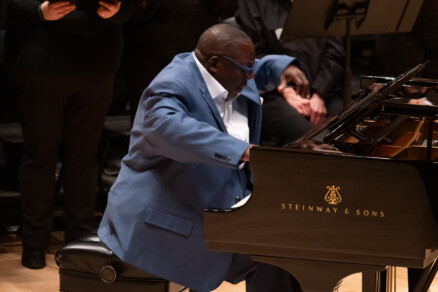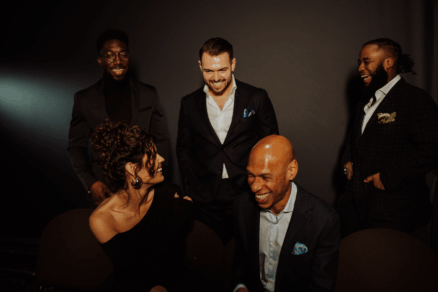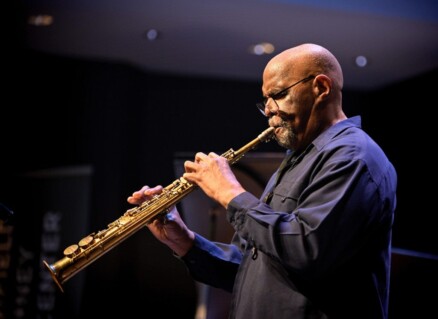Myra Melford on solo piano explorations, ignoring boundaries and finding ‘what’s next’

The pianist Myra Melford has an ear for a wide range of influences, and a deliberate touch developed through years of study. They’re qualities she shares with the late Don Reich, whose paintings inspired her latest album, Life Carries Me This Way. It is a collection of stirring solo piano meditations, but it comes off as a kind of warm dialogue between two dedicated artists. Melford sets up complicated rhythms and playfully interacts with them; sometimes she lays out a subtle drone through repetition, and before you know it she has built it into a flurry of pianistic sounds — let alone notes. Each track on the record feels like a complete statement, a finished work of art.
Born and raised in the Chicago area, she was exposed to a wide range of approaches to the music. After attending college in California, equipped with new technical facility and a theoretical understanding of music, she moved to New York City to seek out the masters whom she had heard on recordings and in concerts out west, ready to absorb their teachings and apply them to her own creative concept. Since that time, Melford has blossomed into one of the most standout pianists of her generation.
Seeking to expand her palette, she was awarded a Fulbright scholarship in 2000 and traveled to India to study Hindustani classical music. This, along with her engagement with Sufism and the works of its great poets, showed her new ways to weave through the tricky rhythms set up by her band while gently and subtly expanding harmonic tension. On her hypnotic, immersive solo material, she leans on these influences even more heavily.
Her relentless striving to break musical boundaries has won her a string of recent accolades: Just last year, the Guggenheim Foundation awarded her a fellowship, and the Doris Duke Foundation selected her for both its Performing Artist Award and its residency program, aimed at building demand for the arts. Ahead of her solo piano performance tonight at the Strathmore, I spoke to Melford about her influences, her concepts, and the nature of being a musician in constant search of an original voice.
CapitalBop: Explain some of the difficulties of performing solo piano. What are some of the challenges and opportunities that come with making this type of recording?
Myra Melford: This project came together because of Don Reich, who was a Sacramento-based artist, who sadly passed away a couple of years ago before I finished the project. He’s an old family friend. When I moved to California to start teaching at UC-Berkeley, he and I started talking about collaborating on a project somehow. He gave me about 16 of his drawings, and told me to do what I wanted with them. He sent me nice JPEGs and I printed them out and hung them up in my studio and lived with them for a couple of years and really thought a lot about how I would make music inspired by these drawings. So rather than trying to translate them, I thought of it more as a dialogue. So I would look at an aspect of a particular painting — say it’s very abstract — then that would lend itself to this way that I like to play the piano, so it really became a conversation for me. I ended up creating pieces for 11 of his drawings.
The reason why I waited so long to make a solo record is because it is very challenging. So many people have done it so beautifully, and I wanted to take some time to think about what I could contribute to that genre, rather than just making a record of some of my pieces that I do with my band. I wanted to create a special set of music that would be for solo piano, and specifically for myself to play. I thought a lot about all the different ways I like to play the piano and the kind of music I like to make. Everything from very lyrical and melodic and rhythmic to quite far out and abstract and energetic. Thinking of various mentors, like Cecil Taylor and Don Pullen and Andrew Hill and Randy Weston. I gave it a lot of thought and eventually came up with these pieces that I think really suit the way I play the piano. I feel really good about this project because I’m like, “Wow, this is really me.” I’ve been influenced by lots of people, and I like responding to artwork, but in the end this is really my voice as a musician and pianist.
CB: Essentially this is a type of mixed-media collaboration, a meeting between a visual artist and a musician. You’ve also done projects working with electronic musicians and laptops. As someone who has explored these sorts of collaborations, what are some ways you observe technology affecting music, more specifically in jazz and improvised music?
MM: One thing that I’ve been doing for many years, right from the moment I moved to New York in 1984, is exploring all of the ways I can make sound on the piano — which included spending a lot of time on the inside of the piano, and figuring out different ways of applying mallets or other types of utensils. In more recent years I’ve discovered a whole palette of sounds that I really like on the inside of the piano, using magnets and caulking material and different ways of changing the timbre of the piano, making it sound like gongs or something else. Because a lot of the sounds on the inside of the piano are so quiet, I had to really work a long time to find a satisfying way of amplifying those sounds so that an audience can hear them, and so that I can improvise with other musicians. In the last year I’ve finally found a way of amplifying the piano that I’m quite happy with.
I’m about to actually make a record with two wonderful improvisers, Zeena Parkins and Miya Masaoka, where I’ll use a lot of this new amplification system and vocabulary inside of the piano. Miya plays koto [a 25-string Japanese instrument] that’s amplified and uses various electronics, and Zeena plays a special electric harp that was made for her, along with electronics. It’s going to be an interesting collaboration to be all able to play our instruments in more traditional ways as well as these more experimental ways. I feel like that’s been one of the cutting edges of creative music. I feel like in terms of jazz and improvised music, the AACM were doing a lot to push this envelope. They too, in turn, were being influenced by and influencing other experimental composers. So I think this whole idea of exploring sound for sound’s sake and “How do we make music out of it?” has been a big part of 20th century music and will continue into the 21st century.
CB: Since you brought up the AACM, they and other similar organizations of the time were as engaged in creating groundbreaking music as they were in community enrichment. Can you talk about how they influenced your music and your personal philosophy?
MM: I grew up outside of Chicago, but I didn’t meet any of the members of the AACM until I was a college student at Evergreen State College in Olympia, Washington. One of the earliest groups I heard was a duet of Leroy Jenkins and Oliver Lake, who was a member of the Black Artists Group. I was just a beginning jazz student at that time, and their music just blew me away. I had no idea what they were doing, but I knew that’s what I wanted to do with my life, to figure out what my music was and how I wanted to play the piano and so on. Then after hearing them, I got turned on to a lot of people who were influential to them, like Sun Ra and Eric Dolphy and John Coltrane, some people who were the major innovators of jazz in the late ’50s through the ’60s. I was really interested in anybody who was finding their own way of doing music. It took years to get deep down into that, exploring all of these groups and their music.
CB: It seems like somewhere along the way, with many of these groups, a disconnect became apparent between the music they were making and the community. In many ways this disconnect has influenced how this music is perceived and experienced today. I’m thinking of the common criticisms: “The music is too heavy,” “I don’t understand it.” As someone who is actively engaged in composing and performing this sort of non-idiomatic music, what sort of lessons have you taken from these groups in terms of reaching the audience?
MM: One thing I took inspiration from is that it is important to be oneself and express one’s own voice, and find a way to put it out there. I would say that though some of the musicians from Chicago moved to Europe and eventually to New York and elsewhere, I think they really felt that the community experience of the experimental band coming up in Chicago was very important, and found other ways to have community in New York. Joseph Jarman started an aikido dojo that a lot of musicians went to. There was the Musicians [of] Brooklyn Initiative that Lester Bowie started with Cecil Taylor when I was a young musician there in the late ’80s. I think though they moved away from Chicago and became international artists, there was always a community aesthetic or value that was important.
So I learned that it was important to find like-minded musicians to make music with. If no one was giving you a gig, you put on your own gig. If no one was recording you, you find a way to put on your own music. I think there was a lot of that sense of “We can do this for ourselves” — which came out of their experience with the Black Nationalist movement — that made sense for a lot of people beyond the African-American community. It certainly made sense to artists who were pushing the boundaries or trying to do something that was considered non-commercial.
I also learned from them that it was great to experience the whole world of music out there. They talked about “Great Black Music: Ancient to the Future,” but they were also listening to the European composers and American experimentalists and various kinds of music from all over the world. I learned that it was great to cast a wide net and let anything that you love and find interesting inspire you, and not worry about this idea of, “If it’s jazz it has to follow these strict conventions.” They were really opening the music up and they encouraged me to do the same both personally in my interactions with them and just from the example they were setting.
CB: You’ve also spent considerable time delving into music of other cultures outside of Western music. Could you talk about those experiences and how they’re reflected in your music today?
MM: I’ve certainly listened to lots of Latin American music and African music, never with the idea of trying to study those traditions deeply and play it authentically, so to speak, but rather to allow it inspire me and see how it filters through my own sensibility. The main place I spent time studying was in North India. I had a Fulbright scholarship in 2000 and 2001, and I went to Calcutta to study North Indian music with a wonderful harmonium master there. I wasn’t so much studying the harmonium, which is a fairly simple little hand-pump organ, but I was studying that music and because I am a pianist it made the most sense to play it on a keyboard instrument.
I got a lot deeper into the practice of that tradition than some of the other music I was listening to, but it was really when I got home and started to write my own music for my band, Be Bread, that I started to hear the influence of that music — but really how I was starting to make it my own and not trying to copy that tradition. Certainly there is the use of modal systems that Coltrane and Miles Davis were exploring in the early sixties, taken to another level with much more complex scales and so on. Then there was a lot of the very complex rhythmic approaches that Indian music takes, lots of polyrhythms. Then it was also some of the song forms that it would start with a slow introductory kind of thing, where little by little you would get to understand the melodic and sound world that you’re in and then proceed through various written sections and improvised sections. So I’ve experimented with using those ideas in the forms of some of the pieces that I write. I think it’s affected me in a lot of different ways, but I don’t think about it very consciously anymore. I think it’s just become a part of my vocabulary as both a player and composer.
CB: Now that you have arrived at a point where in many ways your artistry has been thoroughly demonstrated with a vast body of work and a high level of artistic achievement, how does it feel as you reflect on your career while still actively engaged in your development?
MM: It feels great! I’ve been getting this solo project done, and I’ve also completed probably the most ambitious multi-disciplinary project of my career, called “Language of Dreams,” which just premiered this fall. That’s a 90-minute piece that udavses text from Eduardo Galliano’s trilogy The Fire Trilogy, plus a dancer, plus wonderful video work by David Szlasa, and my new band, Snowy Egret. Completing that work was huge. I feel at once a great sense of accomplishment and a feeling like, “What’s next?” What can I do to challenge myself now? What’s scary? What’s unfamiliar? So I’ve got several ideas for new projects that I’m going to begin to prepare for, but I feel like I can take a breather and really do some studying about orchestration and different kinds of technologies and really start working on a new body of work that is a departure from what I’ve already done.
—
Myra Melford performs at the Strathmore Mansion at 7:30 p.m. tonight. Tickets are available here, and more information is here.
DC, DC jazz, jazz, Myra Melford, solo piano, Strathmore, Washington


